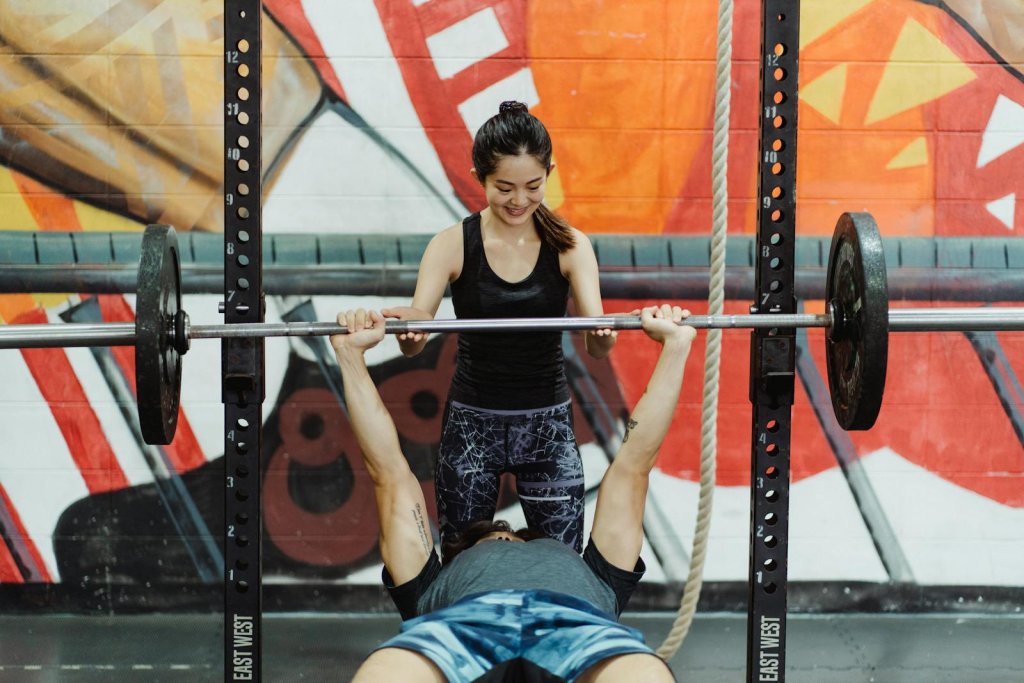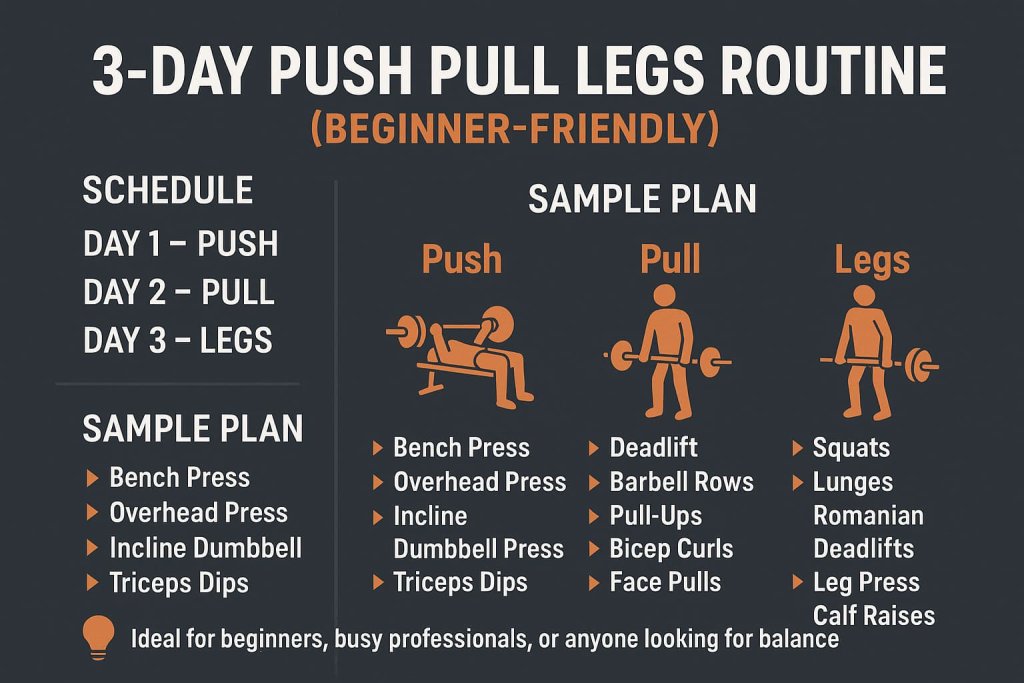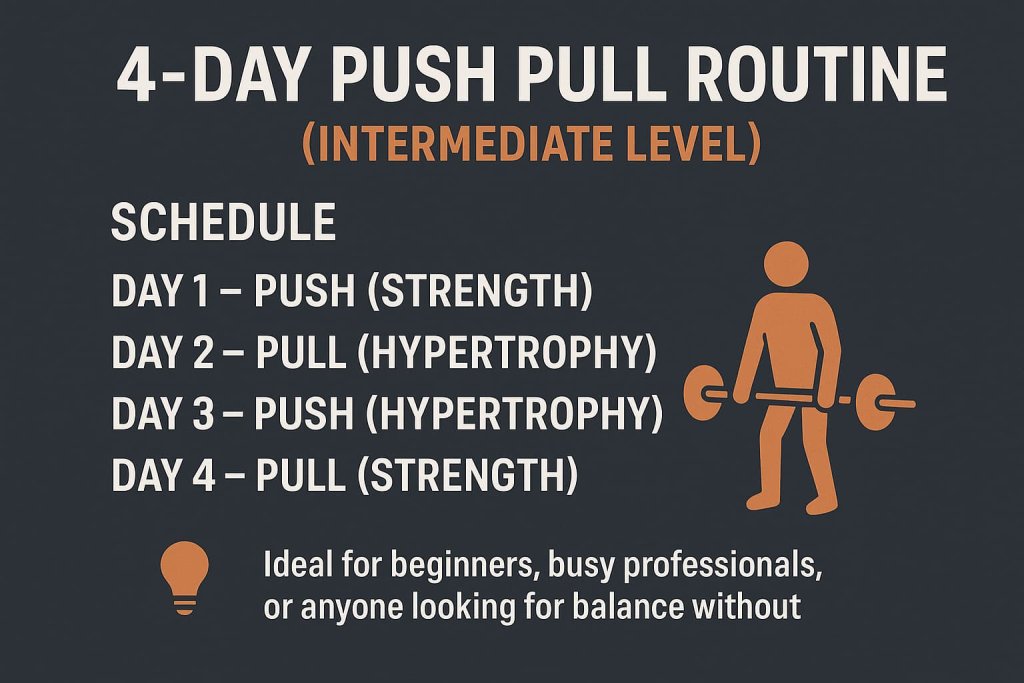A push pull workout routine is one of the most effective ways to build muscle and strength because it divides training into push days (chest, shoulders, triceps) and pull days (back, biceps, forearms), often combined with a dedicated leg day. This setup allows for maximum recovery, balanced training, and flexibility whether you train 3, 4, or 6 days a week.

If you’re struggling to choose the right workout split, the push-pull method offers a simple yet powerful structure. It ensures every major muscle group gets worked while preventing imbalances. Beginners can start with a 3-day push-pull-legs (PPL) split, while advanced lifters can push for 6-day programs to maximize growth.
What Is a Push Pull Workout Routine?
A push pull workout routine organizes exercises by their movement pattern:
- Push exercises: Focus on pressing movements. Example: Bench press, overhead press, squats, dips. These target the chest, shoulders, triceps, and quadriceps.
- Pull exercises: Focus on pulling movements. Example: Deadlifts, barbell rows, pull-ups, curls. These work the back, biceps, forearms, hamstrings, and rear delts.
- Legs (optional in PPL): Covers quads, hamstrings, glutes, and calves through squats, lunges, Romanian deadlifts, and calf raises.
According to Healthline (2025), the push-pull structure is efficient because it allows 48–72 hours of rest per muscle group while still letting you train consistently throughout the week.
Why Choose a Push Pull Routine?
Choosing the right training split matters for both results and long-term sustainability. Here’s why the push-pull method is so popular:
- Balanced development – Equal focus on front and back muscles, reducing risk of rounded shoulders or posture problems.
- Better recovery – Push muscles rest while pull muscles are trained, and vice versa.
- Adaptable schedule – Works with 3, 4, or 6-day weekly splits.
- Scalable intensity – Suitable for beginners focusing on form and for advanced lifters chasing heavy progressive overload.
- Efficiency – Streamlines workouts and reduces wasted time in the gym.
- Proven effectiveness – Widely used by athletes, bodybuilders, and fitness enthusiasts worldwide.
Fun fact: A study published in the Journal of Strength and Conditioning Research (2024) found that push-pull splits led to better muscle symmetry compared to bro splits (chest day, arm day, etc.) when volume was equalized.
Push Pull Workout Splits Explained
1. 3-Day Push Pull Legs Routine (Beginner-Friendly)

Schedule:
- Day 1 – Push
- Day 2 – Pull
- Day 3 – Legs
Sample Plan:
- Push: Bench press, overhead press, incline dumbbell press, triceps dips.
- Pull: Deadlift, barbell rows, pull-ups, bicep curls, face pulls.
- Legs: Squats, lunges, Romanian deadlifts, leg press, calf raises.
👉 Ideal for beginners, busy professionals, or anyone looking for balance without overtraining (Hevy App, 2025).
2. 4-Day Push Pull Routine (Intermediate Level)

Schedule:
- Day 1 – Push (Strength)
- Day 2 – Pull (Hypertrophy)
- Day 3 – Push (Hypertrophy)
- Day 4 – Pull (Strength)
Sample Plan:
- Push Strength: Squats, bench press, overhead press, weighted dips.
- Pull Hypertrophy: Romanian deadlift, barbell rows, lat pulldown, curls.
- Push Hypertrophy: Incline dumbbell press, lateral raises, chest flys, triceps extensions.
- Pull Strength: Deadlifts, chin-ups, shrugs, barbell rows.
👉 Great for lifters who want both strength and muscle growth (StrengthLog, 2025).
3. 6-Day Push Pull Legs Routine (Advanced Level)
Schedule:
- Day 1 – Push
- Day 2 – Pull
- Day 3 – Legs
- Day 4 – Push
- Day 5 – Pull
- Day 6 – Legs
Sample Plan:
- Push: Bench press, incline press, shoulder press, lateral raises, skull crushers.
- Pull: Deadlifts, pull-ups, barbell rows, face pulls, hammer curls.
- Legs: Squats, lunges, Romanian deadlifts, leg press, calf raises.
👉 Best for advanced athletes who want high volume, maximum muscle growth, and faster results (SetGraph, 2025).
Best Practices for Push Pull Training
- Prioritize compound lifts: Always begin with bench press, squats, or deadlifts before moving to isolation exercises.
- Balance push and pull volume: For every pushing set, include an equal pulling set to prevent shoulder imbalances.
- Progressive overload: Increase weight, sets, or reps weekly to stimulate growth.
- Use proper warm-ups: 5–10 minutes of mobility, stretching, and light sets help prevent injury.
- Track rest: Allow 48–72 hours between working the same muscle group.
- Don’t skip legs: Even if you follow a push-pull split without legs, always train lower body to build symmetry and strength.
Common Mistakes to Avoid
- Skipping legs entirely – Leads to imbalances and weak foundation.
- Overtraining push muscles – Many focus too much on chest and shoulders, neglecting back strength.
- Ignoring progressive overload – Doing the same weights/reps won’t deliver results.
- Poor recovery – Not sleeping or eating enough slows growth.
- Bad form – Especially on deadlifts and bench press, which carry injury risk if done wrong.
People Also Ask (FAQs)
1. Is push pull good for beginners?
Yes. A 3-day push pull legs routine is simple, effective, and beginner-friendly.
2. How many days a week should I train push pull?
Beginners: 3 days, Intermediates: 4 days, Advanced lifters: 6 days.
3. Can push pull routines build both strength and size?
Yes. Lower-rep heavy lifts build strength, while higher-rep accessory work builds muscle size.
4. Do I need to rest between push and pull days?
Not necessarily. Push and pull target different muscles, so you can train them back-to-back.
5. Can I skip legs in push pull?
It’s possible, but not recommended. Leg training is vital for overall balance and athleticism.
6. Is push pull better than a bro split?
Yes. Push pull offers better balance and recovery, while bro splits often overtrain smaller muscles.
7. How long should each workout last?
About 60–75 minutes, depending on rest periods and intensity.
Conclusion
The push pull workout routine is one of the most efficient training methods, balancing recovery, volume, and intensity for all fitness levels. Beginners can thrive with 3-day routines, while intermediates and advanced lifters can step up to 4-day or 6-day splits.
👉 Start small, focus on form, and gradually increase intensity. For official resources, check guides from Healthline and StrengthLog.
